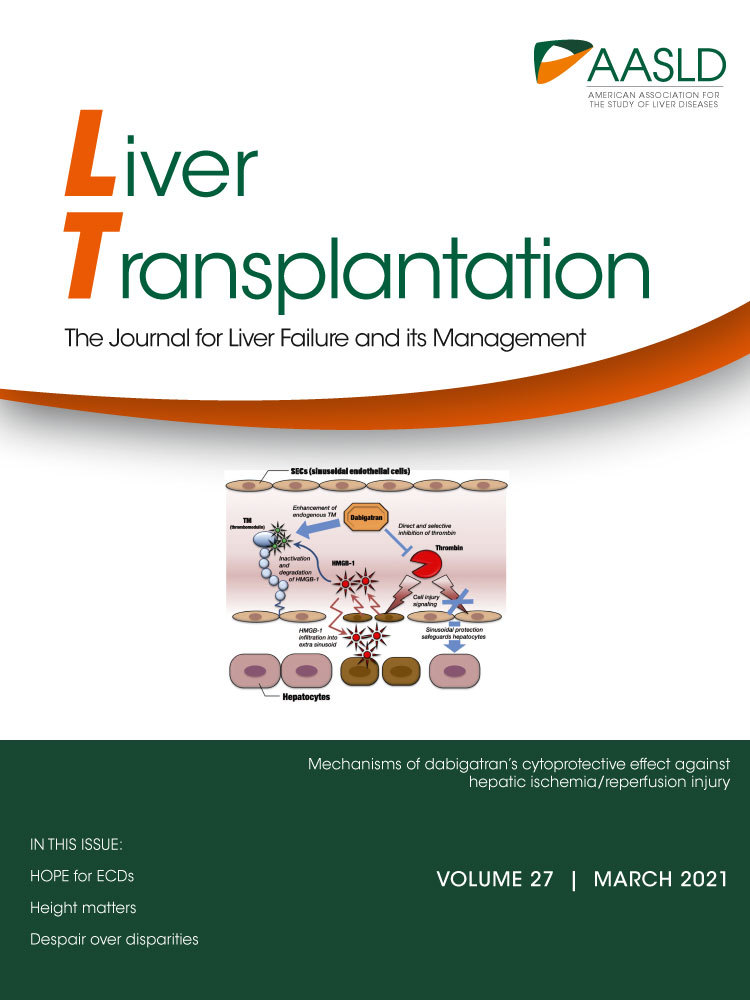Biomarkers for Liver Fibrosis Post–Liver Transplantation: Not As Easy As It Looks
Abbreviations
-
- FIB-4
-
- Fibrosis-4 Index for Liver Fibrosis
-
- LT
-
- liver transplantation
-
- M2BP
-
- Mac-2-binding protein
-
- M2BPGi
-
- Mac-2-binding protein glycosylation isomer
Liver biopsy remains key in the evaluation of hepatic dysfunction in liver transplant recipients. Concerns about its invasive nature and potential risks limit its acceptance by patients. Sampling error is another concern. Expert interpretation by an experienced pathologist is also necessary to optimize its utility. Despite these limitations, it retains an important role in managing patients.(1) However, development of markers of liver injury is an important area of investigation.
In the current issue, Kimura et al. studied the utility of Mac-2-binding protein glycosylation isomer (M2BPGi) for the assessment of liver fibrosis in the post–liver transplantation (LT) setting.(2) Mac-2-binding protein (M2BP) is a secreted glycoprotein present in the extracellular matrix and has been shown to correlate with liver fibrosis.(3) As specific glycan structures of M2BP change as liver fibrosis progresses, measuring M2BP with an altered glycan structure, that is, M2BPGi, was proposed as a marker for fibrosis. Several studies have reported on its utility in viral hepatitis (and to a lesser extent, other etiologies of chronic liver disease) and cirrhosis and hepatocellular carcinoma prediction.(4) In 233 patients with a post-LT biopsy, Kimura et al. demonstrate that M2BPGi in this setting also correlates with the degree of fibrosis.(2) Its diagnostic accuracy (using biopsy fibrosis staging according to METAVIR as the reference standard) is, however, moderate, and not superior to other biomarkers, including liver stiffness measurement and the Fibrosis-4 Index for Liver Fibrosis (FIB-4).
The reference standard has the important limitation of sampling variability, and fibrosis patterns may differ by etiology, requiring disease-specific staging systems (METAVIR was designed for viral hepatitis, but only 29 of these posttransplant patients had active viral hepatitis, ie, hepatitis C recurrence). The study highlights the confounding effect of necroinflammatory activity on the results.
The fibrosis pattern, stage, or amount identified on a liver biopsy, a snapshot observation, is, although a static image, the consequence of underlying active processes. The markers measured in serum samples mostly result from these processes, not from the fibrotic tissue seen on the biopsy. In the study by Kimura et al., signs of liver damage and inflammation on the liver biopsy were reflected by the necroinflammation activity index and therefore tend to correlate with fibrosis stage in several liver diseases, and changes in disease activity over time also correlate with changes in fibrosis stage.(5) It is hence not surprising that a biomarker such as M2BPGi seems to tell more about ongoing necroinflammatory changes than the degree of liver fibrosis.
This study helps us understand the value of this particular biomarker and is therefore also helpful in improving our understanding on how to use biomarkers in general in clinical practice. Using a biomarker to assess fibrosis stage is probably mostly a too simplistic approach.(6) We need to understand what the processes are that are reflected by the biomarker to know what the biomarker can tell us and—at least as important—what it does not tell us. It is highly unlikely that biomarkers will give us the same complex information as a liver biopsy. However, in many cases we do not need all the details a liver biopsy provides. Targeted questions can be addressed with different biomarkers as long as it is clear what the biomarker represents and in which context. Liver stiffness, first validated in viral hepatitis as a marker for fibrosis, is accurate to identify advanced fibrosis and cirrhosis, but it is not accurate for the exact staging of the disease and needs disease-specific cutoffs. As it rapidly declines after viral suppression (illustrating that the value is also influenced by inflammation), its significance in follow-up still warrants further study.(7) FIB-4, another fibrosis index also tested in this study, had only moderate utility during follow-up in a large population-based study.(8)
Elevation of M2BPGi posttransplant can tell us something about the presence of significant necroinflammation in the graft, but it will not tell us whether this is rejection, disease recurrence, or drug toxicity. The authors show in separate sections the relation of the marker with the rejection activity index or with the recurrence of hepatitis C, but again this illustrates that the level M2BPGi correlates with activity of the damage and inflammation and hence the severity of the process, regardless of the etiology. It is hence mainly a marker of disease activity, and therefore, although this remains to be proven, might hold promise in follow-up to monitor the efficacy of treatment measures that are taken.
In summary, the study by Kimura et al. provides further insights in the value of M2BPGi as a biomarker of disease activity rather than fibrosis per se and insights that are relevant to the biomarker field, which needs to correctly interpret the performance of biomarkers and the information they provide in a given context of use.




